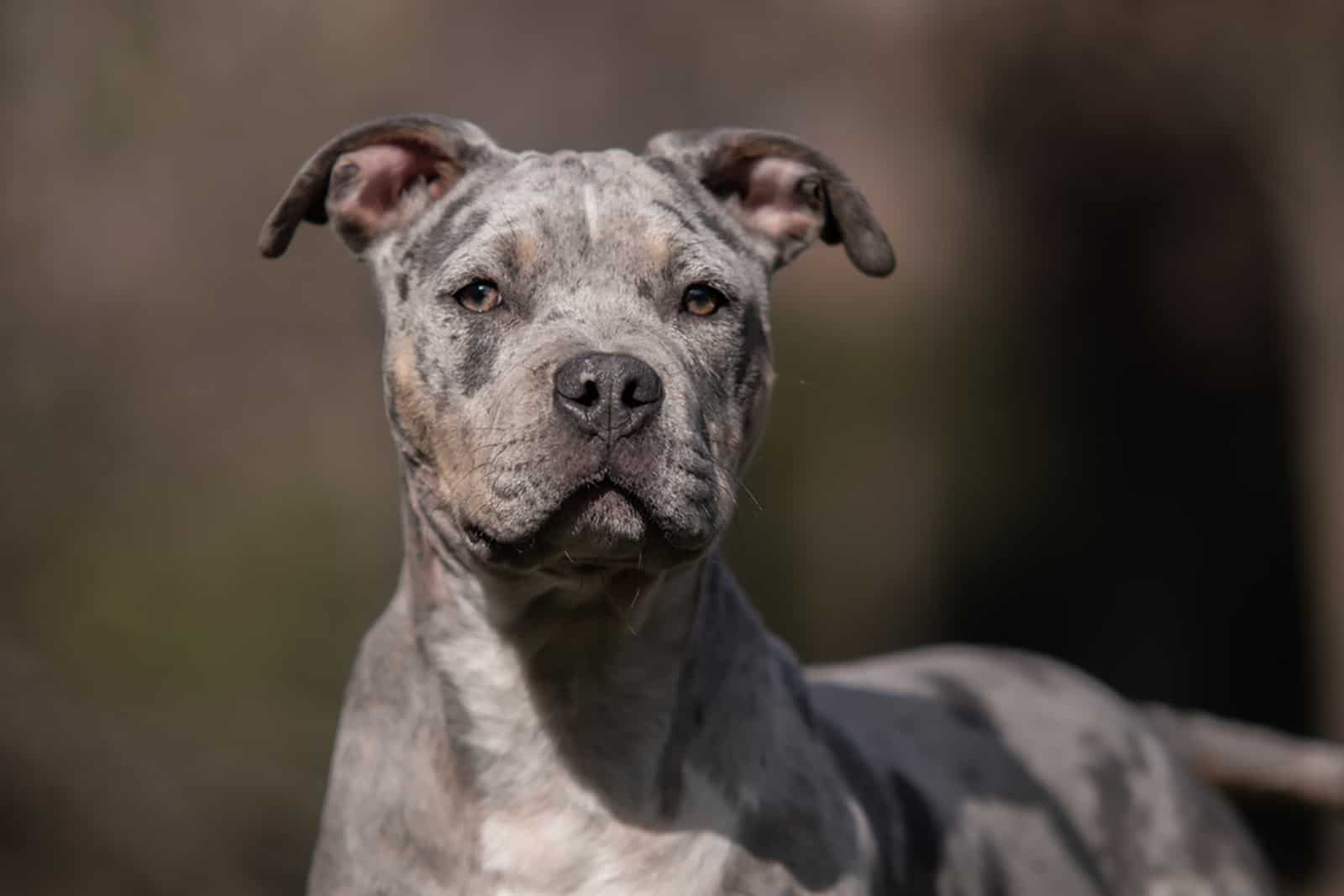A merle American Bully is truly a one-of-a-kind breed of dog that you can easily recognize just by looking at them. Their distinctive coat is what makes them stand out from many other dog breeds, and even from other types of American Bullies.
What makes the merle American Bully breed special and what are its origins? In this article, we will be looking at the unique aspects of the breed, including the health issues that are often associated with them.
We will also be answering some of the most commonly asked questions about this breed, so make sure to keep reading, particularly if you are thinking about getting yourself a merle American Bully puppy.
What Is a Merle American Bully?
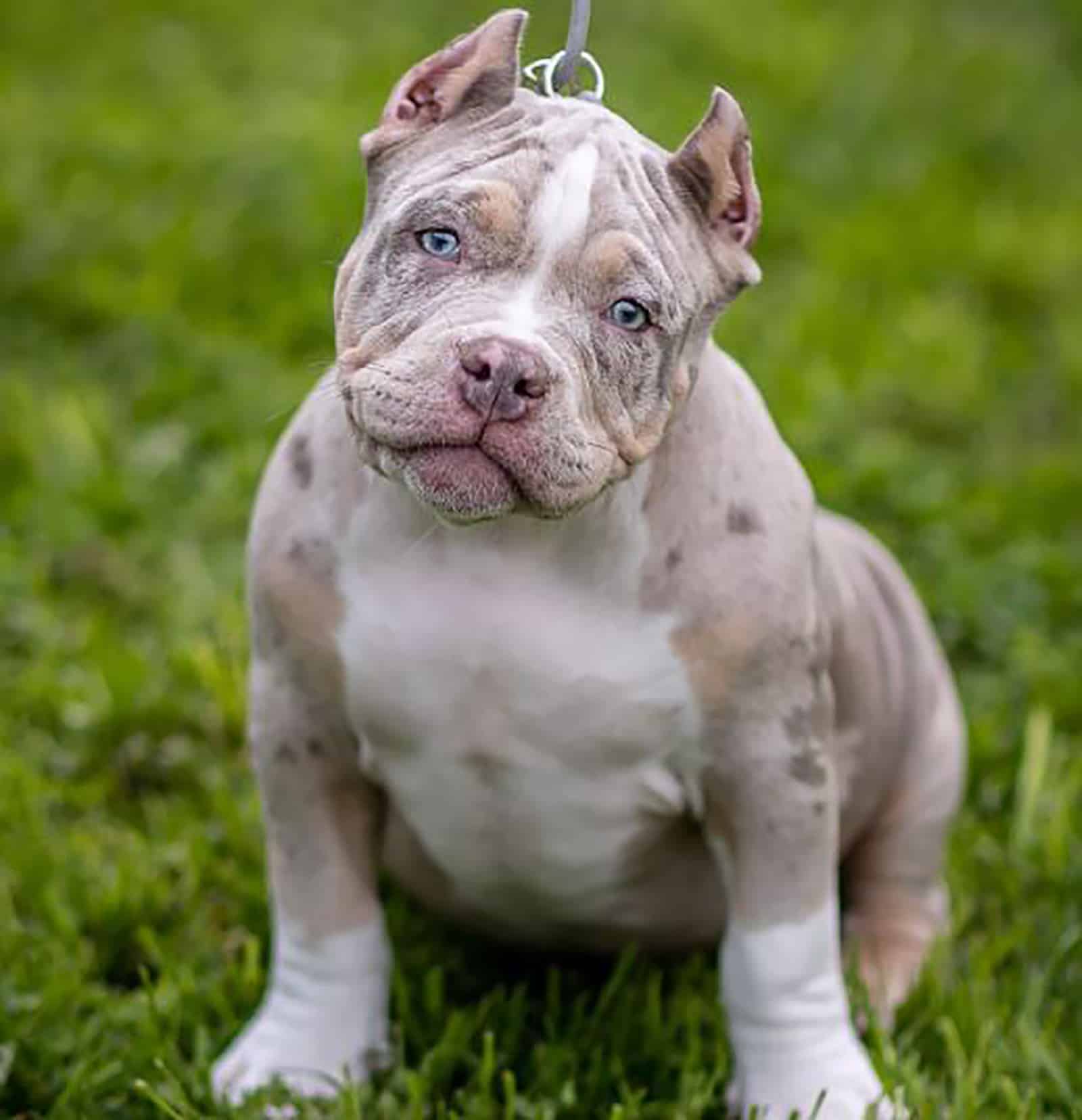
Photo form: @pups.bully
American Bully is a modern dog breed that started its development in the 1980s and was completed sometime in the 1990s.
They are characterized by their distinct appearance, and their amazing strength, especially for their size.
According to the American Bully growth chart, these dogs only grow up to 20 inches (50 cm) in height and weigh anywhere between 44 and 132 lbs (20 to 60 kg).
Now, since this is quite a wide range of sizes, the ABKC has officially divided them into four separate categories according to their height. Those four categories are: standard, pocket, XL, and classic.
Four Categories of American Bully
Standard American Bully
Standard is the most common sort, with a height between 17 to 20 inches (43 to 51 cm) in males and 16 to 19 inches (41 to 48 cm) in females. They are usually pretty bulky and muscular.
Pocket Bullies
Pocket Bullies, as their name suggests, are the smallest variant recognized by the ABKC. It includes males smaller than 17 inches (43 cm) and females no bigger than 16 inches, but no smaller than 13 inches.
XL American Bully
Another type of American Bully with a fairly descriptive name, the XL American Bully is the biggest of the four categories, with males ranging between 21 inches (51 cm) and 23 inches (57 cm), and females between 19 inches (48 cm) and 22 inches (54 cm).
Classic Bully
While a classic Bully might sometimes get confused with the standard category, there are distinctive differences between the two. They fall within the same height parameters, but Bullies of the classic type are much leaner and have a lighter frame.
You could almost be forgiven for confusing them with another breed, like the American Pit Bull Terrier or even American Staffordshire Terrier.
What about merle Bullies?
Merle Bullies are a very special sub-type of this breed, and they can fall into any of these four classes regarding their size. What makes them special — and gives them their name — is their coat color.
They are characterized by the so-called merle gene, which gives them a truly unique pattern that differentiates them from other related breeds.
Personality and Temperament
When it comes to their temperament, they are very adaptable and receptive to training. This means that their personality will depend greatly on their owner and the way they train them during their puppyhood.
While they are not highly aggressive by nature, if they aren’t raised correctly, these traits might arise in their behavior, and sometimes even lead to them becoming dangerous.
This only further underlines the importance of early and proper training, as well as choosing the right American Bully breeders.
Knowing that your puppy comes from a good background is an important element, and it can often be the stepping stone from which you can develop them into a kind, well-behaved adult dog.
7 Common Questions About Merle American Bullies

Photo form: @murdough88
Since they are a fairly unique and rare dog breed, people usually have a lot of questions about them. Whether it’s about their appearance, background, pedigree, or relation to other breeds, you could say that there is a lot to learn about these dogs.
We have gathered some of the most frequently asked questions about merle dogs, and we are going to answer all of them for you here.
1. Are Merle American Bullies Related to Pit Bulls?
Well, yes and no.
The merle American Bully is not itself a Pit Bull, but it was bred by combining the American Staffordshire Terrier, which is a Pit Bull-type breed, with American Pit Bull Terrier, which also falls into the Pit Bull family.
Because of this, they share a lot of the same genes, hence the somewhat similar appearance.
Pit Bulls aren’t the only breed that Merle Bullies get mistaken for. They sometimes get confused with American Bulldogs or regular Bullies that have a brindle-type coat.
This is understandable since there are enough similarities in the way they look to make everyone look twice.
2. What Is a Merle Coat?
A merle coat is an extremely specific pattern of dog coat, recognizable by blots and patches of color on a coat that is otherwise solid or piebald.
It is caused by a genetic mutation — sometimes referred to as the merle gene — that can also affect a dog’s eye color or even the skin pigment itself.
Typically, this type of coat in American Bullies requires extensive grooming. Regular cleaning and brushing are advised to keep their fur healthy and stop it from tangling.
3. What Causes a Merle Coat?
The merle coat is usually the product of a genetic mutation, and that is most often the result of breeding.
If a merle Bully is bred with a solid-color Bully, the litter will usually contain some merle Bully puppies, but they can also be born by breeding two solid-color dogs.
There is also the special case of breeding two merle American Bullies, but that is a very controversial practice that we’ll talk about more later in the article.
4. Is a Merle American Bully Purebred
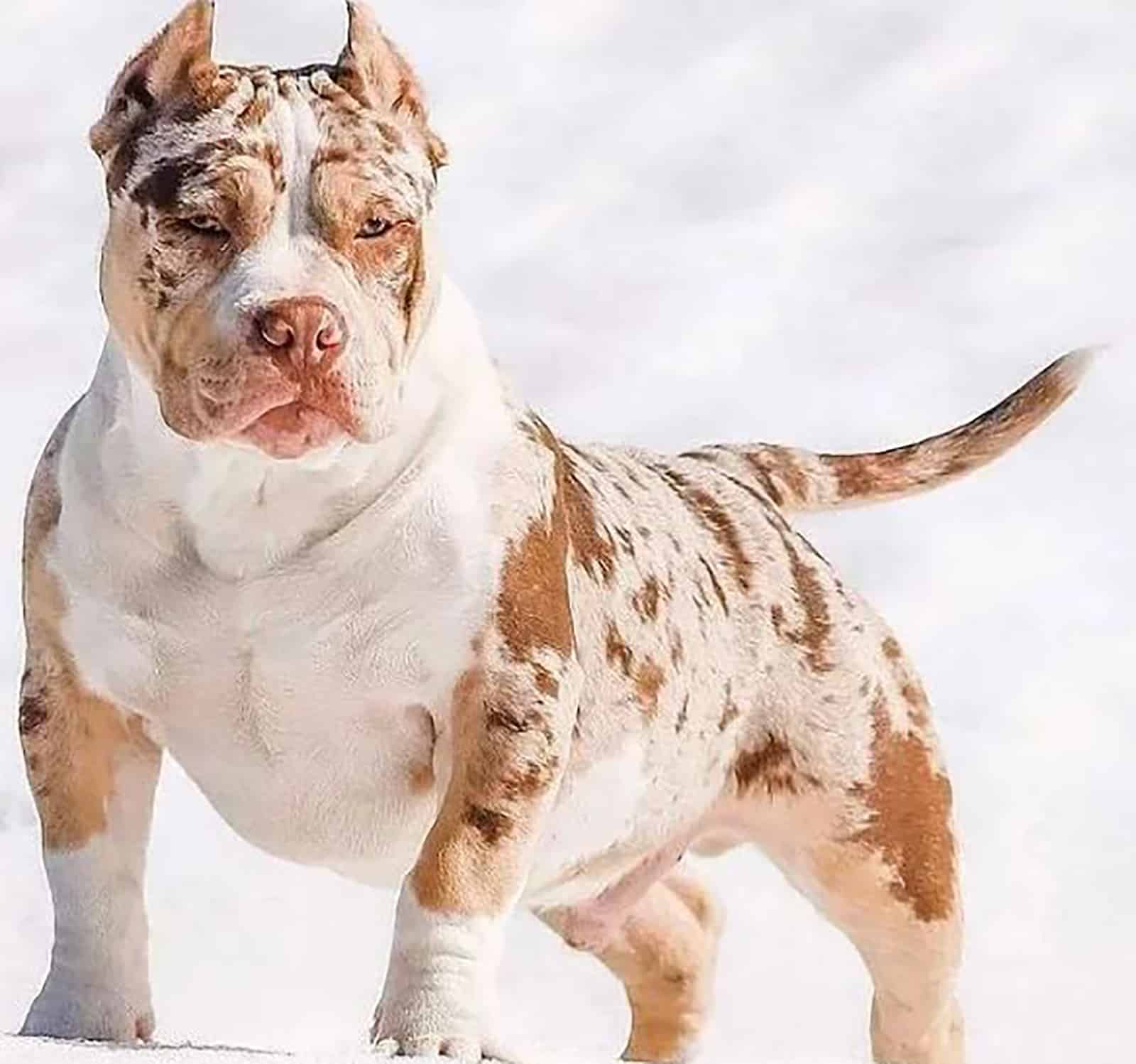
Photo from: @pitbullsoflnsta
No. The American Kennel Club doesn’t categorize any dog from the American Bully family as being purebred, and that includes the merle.
Moreover, the American Bully Kennel Club (ABKC) only officially included it as a breed in 2004, and some of the other clubs waited even longer to recognize them.
Specifically, the European Bully Kennel (EBKC) did so in 2008, and the United Kennel Club (UKC) in 2013.
However, despite not being purebred, American Bullies are surprisingly popular and desirable among breeders and they often attract a high price.
It’s often the moneymaking opportunities that drive some of the breeders, despite all of the associated health questions.
5. What Other Breeds Have Merle Coats?
The merle color can appear in dogs either naturally or as a result of crossbreeding.
Some of the breeds that have a natural predisposition for this pigmentation are, for example, Australian Shepherd, Leopard Dog, Shetland Sheepdog, as well as various other shepherd and collie breeds.
The merle pattern is also a part of the genetic make-up of harlequin Great Danes.
Generally, this type of coat is not officially accepted by the AKC, except in cases where they occur naturally. Examples of this are breeds such as Border Collies and Leopard Dogs.
6. What Is the Stance on the Merle Coat in the American Bully Breed?
While the merle coat is considered beautiful and, therefore, desirable by some breeders, it can also be a source of many serious health issues. We’ll get into more details on these issues later on in the article.
For now, let’s just say that there are concerns over their health, as well as the long-term effects that inbreeding can have on the bloodline.
This has caused a lot of people in the community to speak out against the American Bully breeding programs, calling them unethical, and occasionally asking for them to be stopped completely.
So it would be safe to say that merle Bullies are fairly controversial and generally frowned upon among many breeders and owners alike.
7. Does the AKC Accept Merle American Bullies?
The AKC does not have the American Bully on its registry for all of the previously mentioned reasons regarding breeding, purity, and bloodline.
AKC standards are very strict when it comes to accepting any new breeds, so even if we discount all the sensitive issues surrounding merle dogs, the mere fact that they were developed so recently makes it harder for them to be accepted.
The merle American Bully itself isn’t in the registry, but there are some breeds with the merle gene that meet the AKC standards.
We’ve already mentioned the likes of Border Collies and Leopard Dogs, but some other examples include Australian Shepherds, Dachshunds, Great Danes, Cocker Spaniels, Chihuahuas, and others.
Types of Merle American Bully
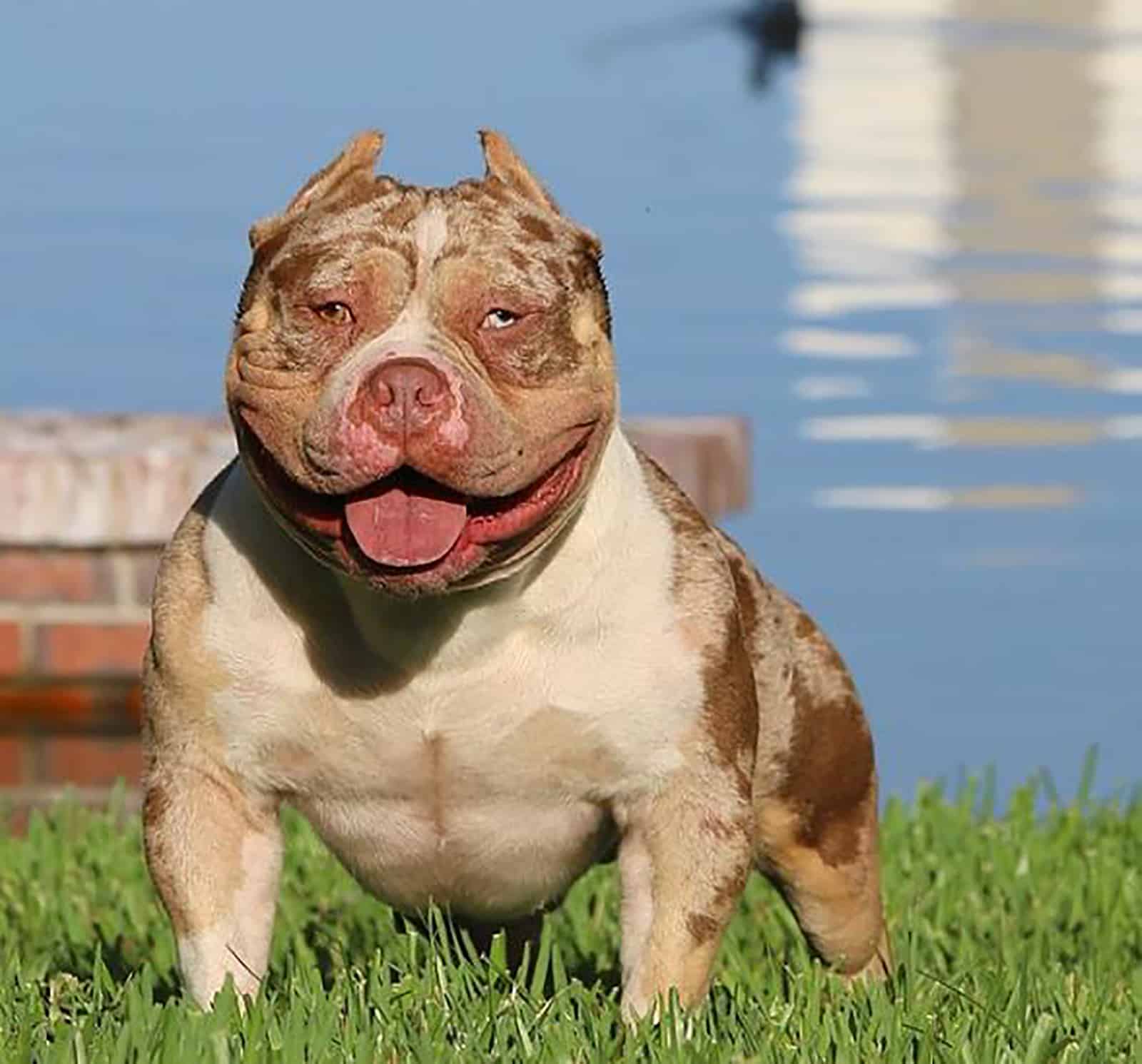
Photo form: @murdough88
Generally speaking, there are three different kinds of merle American Bullies, depending on the actual pigmentation of their coat caused by the merle gene.
The three categories are known as blue merle, red merle, and cryptic merle. However, even though two of these are named after colors, their coat is usually not of that color. Slightly confusing, but that’s the way it is.
So let’s dig into it and talk about each of these three types individually.
Blue Merle American Bullies
Even though their name suggests something completely different, blue merle American Bullies are actually black in color, with patches of gray or tan. Admittedly, it would be great if there was a dog that is entirely blue, but that isn’t the case in reality.
They’re called blue merles because those gray areas in their coats occasionally look sort of blue in certain lighting conditions, but that’s about it. In actuality, even those gray and tan spots are pretty rare.
Because of this, they get mixed up with tricolor American Bullies all the time, and vice versa. However, the tricolor Bullies do not have the merle gene as the blue merles do.
Red Merle American Bullies
Just like the blue ones, the red merles aren’t actually red. Their shading is closer to the color of liver, and the mottles in their coat most often come in shades of cream, copper, or white.
Not a far cry from red, as gray is from blue in the other case, but the name is still often misleading.
When compared to blue merles, the red ones are much rarer because they have proven to be much more difficult to create in the process of breeding.
This is because a significantly smaller proportion of merle American Bullies carries this particular gene.
Cryptic Merle American Bullies
If you thought that merle bullies are rare, wait until you hear about cryptic merles.
The most mysterious kind of merles is called cryptic because, even though they possess the merle gene in their DNA, it doesn’t manifest itself in any of the usual ways.
This means that they are neither blue nor red, or that only a tiny portion of their coat has visibly merled.
They can occasionally have spots of black or liver color, but most frequently they will be rather small or totally covered up by fur. So they don’t really look like a merle at all, which often confuses even the keenest dog connoisseurs.
But make no mistake, even though they don’t look like it, they still carry the merle gene in them, and since it’s a dominant gene, they can pass it on to their offspring.
Read More: The Tri-Color Bully Looks Great, Truly
Double Merle American Bully
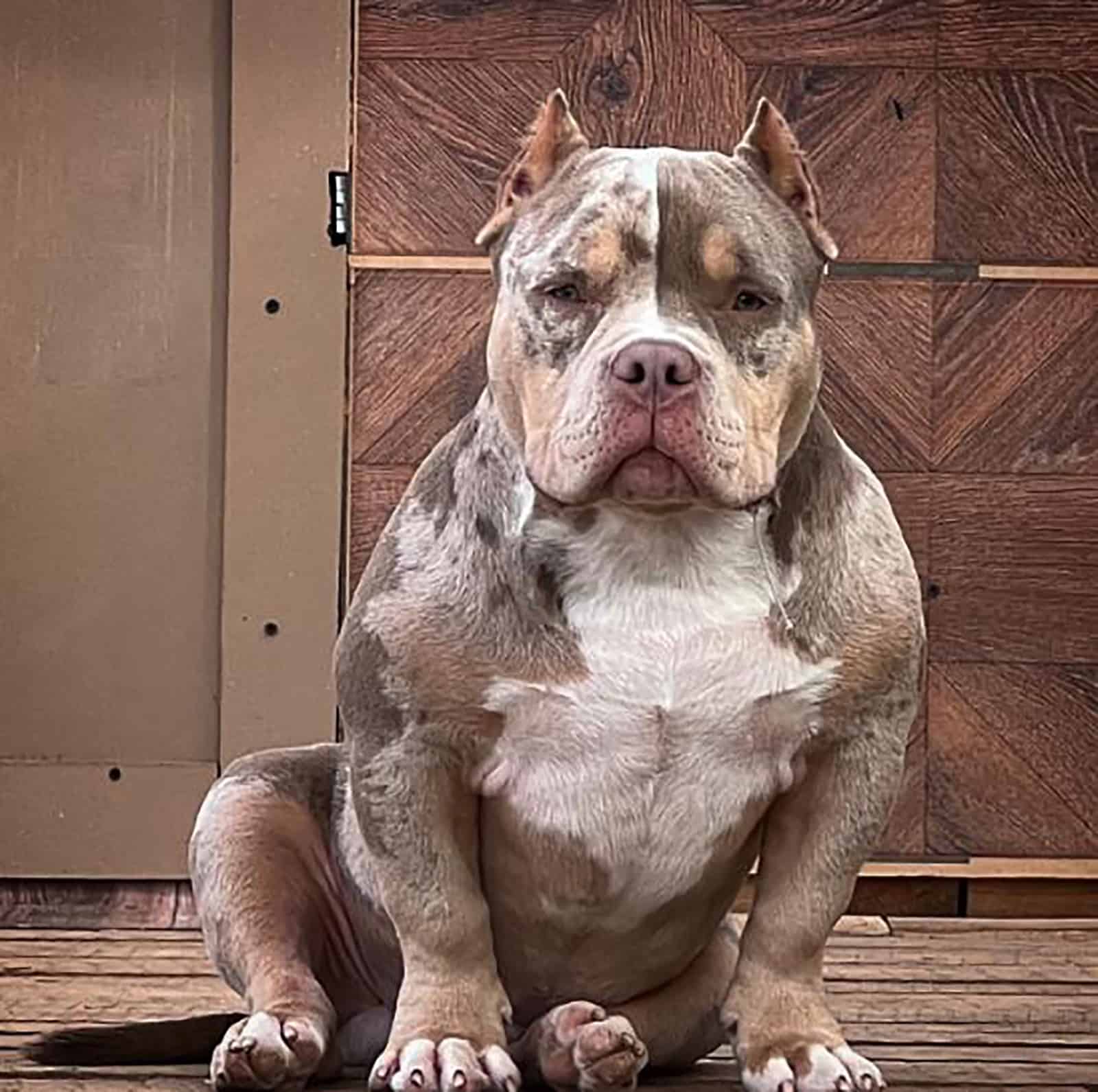
Photo form: @pups.bully
In the segment about the most commonly asked questions, we briefly mentioned the special case of breeding two merle American Bullies, and how sensitive that subject is.
When two fully merle American Bullies produce offspring, there is a 25 percent chance that one of their puppies will be something called a double merle. To explain this as simply as possible:
Regular merle patterns in dogs are created when the dog in question has the Mm genotype. This means that they have one copy of the M allele and one copy of the m allele.
By this logic, every non-merle dog has the mm genotype, while double merles have the MM variant.
These are incredibly rare, but when they do happen, they look nothing like regular merles. Their coats are usually bright white and have no mottles or merled spots on them whatsoever.
Sadly, double merles are extremely susceptible to all kinds of health problems, and some of them are even born with them.
Furthermore, the symptoms can be more severe than in regular merles, and they are the most prominent example of why a lot of people consider merle American Bully breeding to be unethical.
To dig deeper into this topic, let’s touch a bit more on the general health issues that befall all merle Bullies.
Health Issues With Merle American Bullies
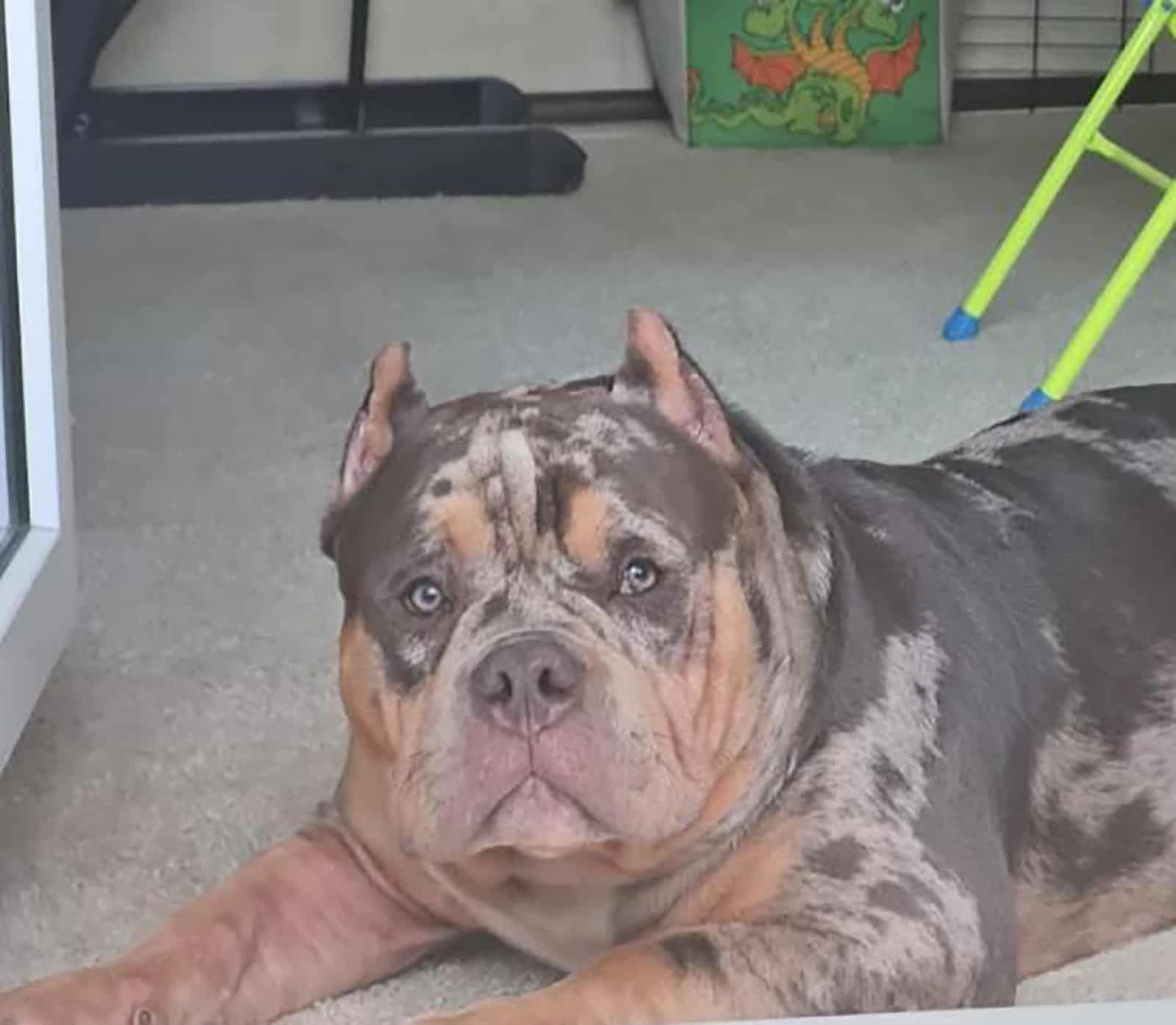
Photo form: @pups.bully
Scientists have long linked the merle gene to a higher risk of many canine medical conditions. The most common ones are related to the health of the ears and eyes, but there are others as well.
Ear troubles are the biggest issue. There are many reports of merle dogs with hearing problems and sometimes even complete deafness.
Owners have noticed their merles developing this as they grow older, but there are even cases of puppies being born completely deaf.
Eye abnormalities are also fairly common in comparison to non-merle dogs, and they represent a huge worry for dog owners.
When describing the appearance of merle bullies and the influence of the merle gene, we said that it can even influence eye color.
This can lead to some gorgeous blue eyes, but it also presents the risk of partial or total blindness.
Other potential risks involve several conditions related to the health of the merle’s bones, heart, and skin.
Health Problems In Double Merles
Double merles are twice as likely to experience severe medical conditions as regular merles are. More often than not, they go through their lives experiencing multiple different conditions, all related to their genotype.
The most frequent problems they face are blindness and deafness, and the statistics are shocking. Studies have shown that around 60% of double merles experience blindness, and up to 75% are deaf.
Skin cancer, liver troubles, and neurological problems are also fairly common with these poor creatures. Here are some of the issues that have been known to affect double merles, which every owner should know about:
• Autoimmune diseases
• Bone and joint-related conditions
• Spina bifida (a defect of the spine)
• Various heart defects
• Water on the brain (aka. hydrocephalus)
As you can see, there are numerous health risks that you need to worry about if you own a double merle. This is why the practice of breeding these dogs in the first place is so questionable.
Should Breeders Continue To Breed Merle Bullies?
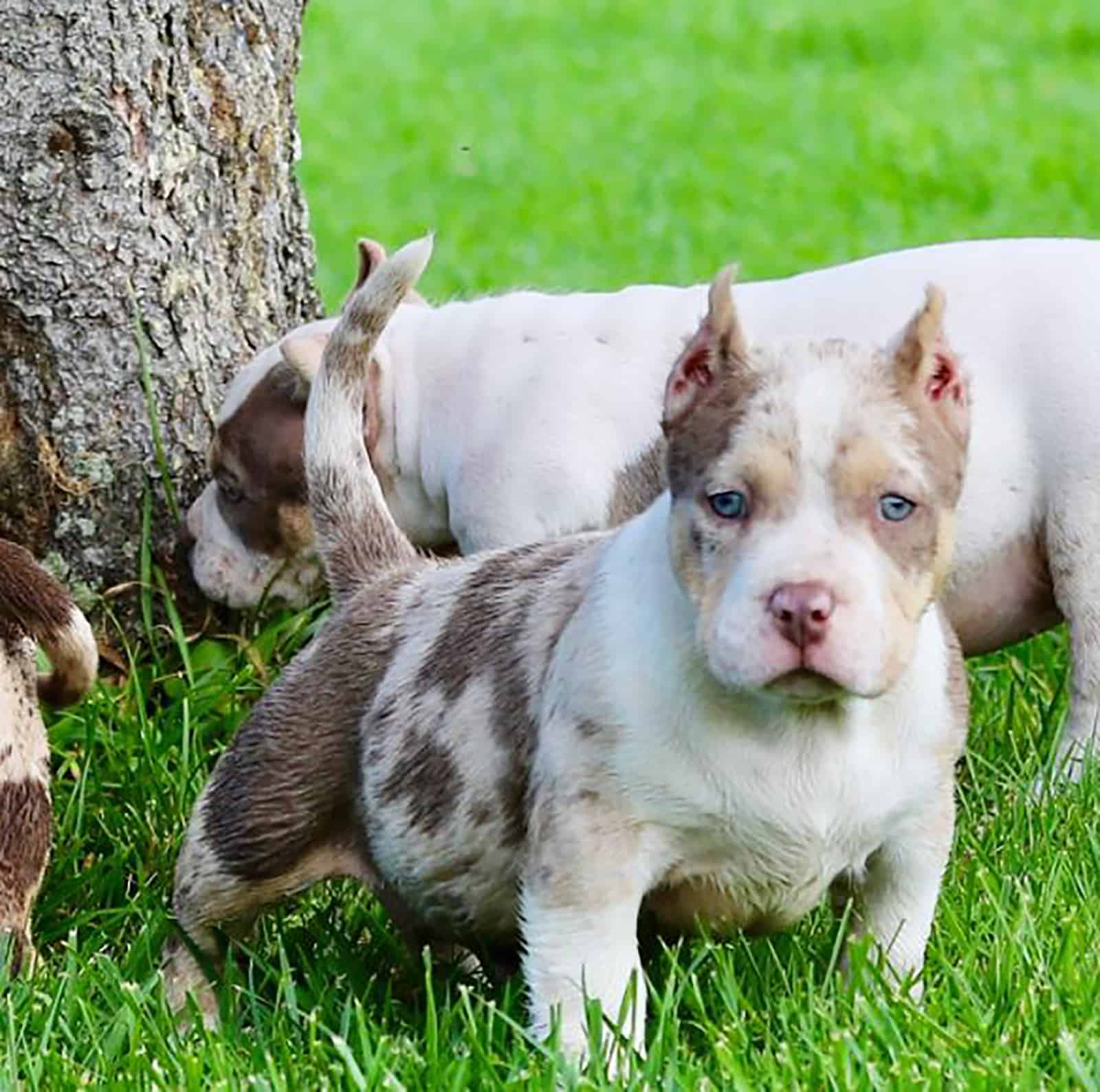
Photo form: @murdough88
We’ve discussed the health risks that merle American Bullies are exposed to, as well as everything that goes into the process of breeding these dogs.
So when we try to draw a line underneath it all, what is the conclusion about the ethics of breeding merles?
The consensus in the community is that it’s a highly unethical practice and should be at least criticized, if not banned outright.
But despite all of this, breeders seemingly don’t plan on stopping it anytime soon. If anything, these practices are becoming more ubiquitous as time goes on, and it’s threatening to be a real problem.
So why does it keep happening?
There are a couple of reasons.
Why Breeders Keep Breeding Merle Dogs
The first possible reason is that merle dogs, and particularly double merles, are bred accidentally, without the breeder knowing the exact genetic make-up of the parents.
While this isn’t ideal, it demonstrates how important it is to do all the necessary research and be well-educated on the topic.
However, the second reason is much more worrying. There are cases of breeders intentionally breeding merles, with the hope of creating a unique color or pattern and selling it for profit.
Obviously, the merle patterns on a dog’s coat can be very visually appealing and that is a strong motive for this kind of breeder.
Furthermore, this goes beyond this specific breed. In recent times, we are seeing more and more different dog breeds being bred to develop the merle pattern. In fact, we can now see it in Poodles, Terriers, Koolies, and Pit Bulls, among others.
This is all in the attempt to create so-called designer breeds, intentionally made to look appealing and one-of-a-kind. Sadly, the motivation behind this is usually profit, and not a lot of thought is put into protecting these poor pups.
The practices of merle breeding and inbreeding are, unfortunately, much more frequent than we would like. It messes up their bloodline and results in a lot of dogs having to struggle with poor health throughout their lives.
Hopefully, this will change with time and unethical breeding will become a thing of the past.
Merle American Bully Cost
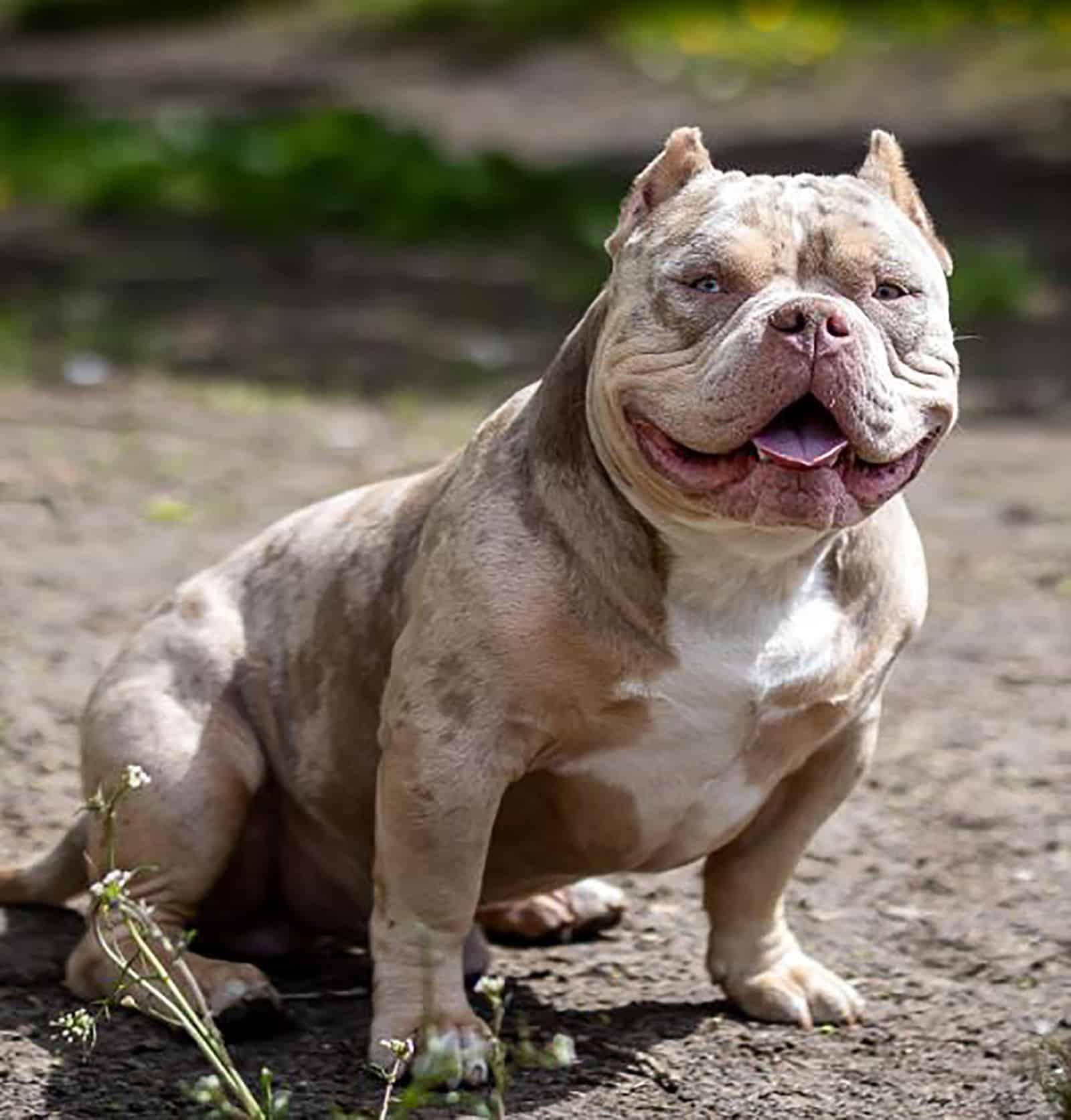
Photo from: @bully_and_bengal
If after reading all of this, you are still in the market for a merle American Bully puppy, then the actual price of one is probably a key factor in your decision-making process.
Even though they are not accepted by the American Kennel Club and are not considered purebred, merle Bullies can command an extremely high price tag.
The average cost is somewhere between $5,000 and $10,000 for a puppy, but this depends on several different factors.
Here are some of the elements that influence the cost of a merle:
• Bloodline — who were the puppy’s parents and what was their health like;
• Breeder reputation — it probably goes without saying, but whenever you decide to buy a puppy from a breeder, it’s important that you know a bit about their background and reputation;
• Where you live — merle American Bullies aren’t equally common in every part of the world, so if you live in an area where they are particularly rare, it might be more difficult to get one, and therefore more expensive;
• Puppy training — the more training the puppy has received, the more expensive it will probably be.
• Type and appearance — we’ve spoken previously about how some breeders will look to breed different merles in order to get unique and interesting merle patterns, which results in higher prices.
There are, of course, other factors that can drive the price up, including some that cannot be predicted. These five, however, can give you a good estimate of a puppy’s quality and cost.
Naturally, this is only the cost of getting the puppy into your hands and does not include the various extra expenses that you are likely to encounter.
Their health is a massive concern so they will require extensive and frequent visits to the vet, as well as carefully tailored diets and supplements.
Medical costs can ramp up quickly in these dogs, so it needs to be planned for before getting one.
The Final Word
After going through all the unique traits of the merle American Bully, we can now see why the breeding programs that produce them are so controversial.
Their many different colors and beautiful merle patches might seem appealing at first sight, but they don’t take away from all the issues surrounding these particular bully dogs.
Ultimately, there are valid reasons for their disqualification from the American Kennel Club and some other kennel clubs as well.
However, if you still wish to get yourself a merle puppy, just make sure that you do the proper research beforehand.
Learn as much as you can about the American Bully breeders in your areas, and take the time to get familiar with the breed itself.
We sincerely hope this article was helpful in that regard and that it will inform your decision.
